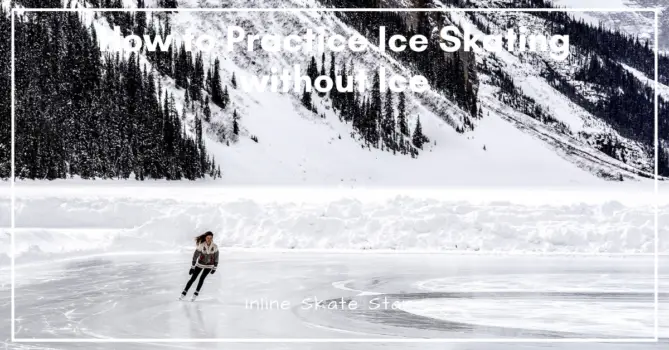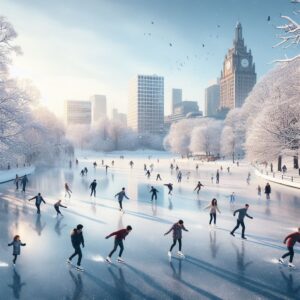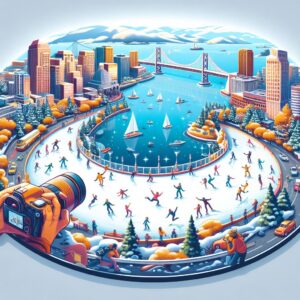How to practice ice skating without ice seems a far-fetched idea in reality. The thought of skating without ice may sound impossible. But guess what? It’s all possible! You don’t need to be on the ice to skate.
You can practice ice skating anywhere, including at home, in the office, or outdoors in your backyard. But how should you go about it?
There are two main ways to practice ice skating without ice: cross-training on rollerblades and doing dryland training and exercises. Rollerblading and ice skating are similar skating disciplines, meaning they share most techniques like stops and turns. So you can practice these techniques on rollerblades then use them on ice skates later.
This is only the scratch on the surface. I cover more detail on how to practice ice skating without ice in the rest of this blog. So, whether you’re into figure skating, hockey skating, speed skating, or recreational skating, I got your back. So, let’s get to it!
Please check out these awesome ice skating shoes on Amazon
Jackson Ultima SoftSkate Womens/Girls Figure Skate
Glacier by Jackson Ultima White Figure Ice Skates for Toddler, Girls, and Women
Riedell Skates – Soar Adult Ice Skates- Recreational Soft Beginner Figure Ice Skates
Ways to Practice Ice Skating without Ice
Like we’ve already seen, there are at least two main ways to practice ice skating without ice. They include cross-training on rollerblades and trying out dryland training and exercises. We’ll cover each of these in detail, including their pros and cons. So, let’s get going!
1. Cross-train on Rollerblades
Is ice skating like rollerblading? You could be wondering. The truth is, there are more similarities between ice skating and rollerblading than there are differences. So, what does this mean?
The quick, straightforward answer is, you can practice ice skating techniques on rollerblades and get better with time. In addition, Rollerblading is done on dry land, meaning you have multiple options of where to go rollerblading.
Most importantly, ice skating and rollerblading use similar skating techniques like bending posture, stopping, and turns. These techniques are critical for your survival and safety when ice skating. The good news is, you can practice them off your ice skates on rollerblades.
The correct skating posture involves bent knees above the toes and shoulders over the hips. This technique is used in all skating disciplines, including skateboarding and roller skating.
Stopping or slowing down when skating is an important skill to learn. Some of the stopping techniques used in rollerblading apply to ice skating. They include snowplow braking, t-stop, power slide braking, soul slide braking, and power stop.
In addition, safe falling is a great way to stop when ice skating or rollerblading. It’s a handy technique for beginner skaters and some intermediate skaters who struggle to learn the different stops.
Lastly, you can practice different turn techniques like cross-overs and flat spins on rollerblades, then use them on ice skates when you get back to the rink. If you’re brand new to rollerblading, it’s not as hard as you may want to believe.
The two skating disciplines, ice skating and rollerblading, are similar in every way. So, if you’re already familiar with the skating basics on ice skates, using rollerblades once in a while should be pretty straightforward. However, the first time may be a hassle. The good news is, it gets better with time.
Other benefits you get from rollerblading that benefits ice skating include;
- All body muscle development and coordination.
- Burning excess body calories.
- Improved cardiovascular and aerobic systems.
2. Trying out Dry Land Training and Exercises for Speed Skating
Dryland training is a technique used mainly by speed skaters to practice ice skating without visiting the rinks. It’s convenient and helps one to stay fit and on form for ice skating.
The good news is, you can use dryland training exercises when practicing figure skating, hockey skating, and recreational skating without ice. Dryland training exercises have multiple benefits like strength building, fitness, balance and stability, rotation, and flexibility.
- They help strengthen all body muscles since ice skating uses all muscles. Stronger muscles can endure the vigorous nature of speed ice skating. That’s why you need them stronger. The good news is, you can get this from dry land training exercises.
- Fitness is important when ice skating. You need to have notch body fitness to do the recommended skating position, which requires staying in the bent posture for a long time. You also need to be fit for top-notch maneuverability.
- Balance and stability are essential when ice skating because they help you prevent falling and fall injuries. Also, you need stability to maintain speed when ice skating. Doing dry land exercises can help a big deal to build your balance and stability.
- Dryland exercises are great for improving your ice skating rotation skills, like spins when doing figure skating.
- Lastly, dryland training helps achieve a high degree of body flexibility when skating outdoors and indoors. The best part is it works for all ice skating disciplines.
There are many dryland training exercises you can try out. Below is a YouTube video you can use to get started in learning different dryland training exercises.
You’ll need a slider board and slide board booties, which you can buy online or at your local store. You also need some oil to apply to the slider board to make it more slippery for even and smooth glide motions.
The dry land exercises to try out on your slider board include the classic speed skater, mountain climber, reverse lunge, front lunge, and side lunge.
How to Practice Ice skating without Ice | Wrapping Up
The best way to practice ice skating without ice is to cross-train with a similar skating discipline like rollerblading. Rollerblading and ice skating share similar techniques like the correct skating posture, stopping, and push and glide techniques.
You can practice these techniques on your rollerblades then use them when you get to an ice skating rink. But if you don’t want to cross-train with rollerblading, you can practice ice skating without ice by doing dryland training exercises.
They’re used mainly by speed skaters, but you can still apply them to recreational skating, figure skating, and hockey skating. Overall, they help strengthen the body, achieve high fitness levels, improve balance and stability, improve rotation skills and achieve notch flexibility.
I hope you found this guide helpful!




